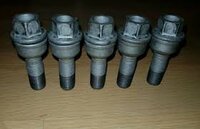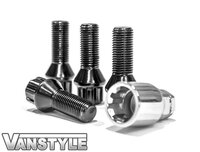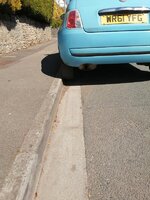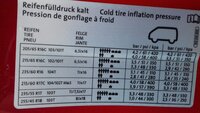You are using an out of date browser. It may not display this or other websites correctly.
You should upgrade or use an alternative browser.
You should upgrade or use an alternative browser.
LOOK At this tyre....
- Thread starter James1000
- Start date
Especially with this sort of parking
View attachment 113914
Unless you look closely, you might not see that the tyre is about 3" off the ground.
I always park 3in off the ground like that, saves wear and tear on the tyre tread.
I've seen budget tyres on BMW M3's and all sorts of performance cars, as well as vans. A mate of mine manages a tyre depot and he says he regularly gets customers in £60K vehicles come in on tyres with literally no tread, asking for the cheapest tyres available and can they do it on finance. Madness.In my opinion if you've spent the best part of £30-50k on a vehicle and you're fitting budget tyres, you're saving money in the wrong place.
Absolutely agree!In my opinion if you've spent the best part of £30-50k on a vehicle and you're fitting budget tyres, you're saving money in the wrong place.
Care to clarify?
Hi, the T6 van bolts are two pieces and are so because they need to be torqued to 180 nm to achive the relevant clamp load and elastic deformation to retain the wheel, as you can see multiple resellers offer bolts that are 1 piece, have a taper not a conical seat, and will not achieve the correct clamp force or torque when tightened, its a constant annoyance of mine as i used to be responsible as senior engineer for wheels and tyres at a VAG group company and i have done many studies on wheel bolts, wheel retention and underatke the VW standard wheel retention test myself and i know first hand the consequences of the wrong bolts


Hi, the T6 van bolts are two pieces and are so because they need to be torqued to 180 nm to achive the relevant clamp load and elastic deformation to retain the wheel, as you can see multiple resellers offer bolts that are 1 piece, have a taper not a conical seat, and will not achieve the correct clamp force or torque when tightened, its a constant annoyance of mine as i used to be responsible as senior engineer for wheels and tyres at a VAG group company and i have done many studies on wheel bolts, wheel retention and underatke the VW standard wheel retention test myself and i know first hand the consequences of the wrong bolts
View attachment 114053View attachment 114054
Interesting.
I have some after market alloy wheels that I use during summer which need a conical bolt, not the OE VW radius seat.
I am not aware of any available two piece bolts for this application.
If the bolt is made of the correct material what is the benefit of the rotating collar when torquing up the bolt? I'm genuinely interested.
Like @T6ARF said earlier, the collar contacts the wheel, stays stationary and stops the rotating bolt galling the wheel surface.Interesting.
I have some after market alloy wheels that I use during summer which need a conical bolt, not the OE VW radius seat.
I am not aware of any available two piece bolts for this application.
If the bolt is made of the correct material what is the benefit of the rotating collar when torquing up the bolt? I'm genuinely interested.
Interesting.
I have some after market alloy wheels that I use during summer which need a conical bolt, not the OE VW radius seat.
I am not aware of any available two piece bolts for this application.
If the bolt is made of the correct material what is the benefit of the rotating collar when torquing up the bolt? I'm genuinely interested.
I too am interested in this. So @RayC are you saying we should not use any wheels that use the conical non-VW bolts, I imagine that is all aftermarket wheels. I am genuinely surprised that if they are not fit for purpose that all aftermarket sellers use these and do not machine their wheels to accept the radius collared VW bolts. (I believe you are mistaken in your post where you imply that VW bolts have a conical seat. I am sure they do not, its the aftermarket that are conical.)
Given that there do not appear to be any taper seat wheel bolts with a 'free' collar, is it that the use of a 'free' collar on the radius seat bolts is driven by the use of the radius seat itself?
Interesting, found these: 20X M14X1.5 304 Stainless Steel Tapered Wheel Bolts Set Fit VW Transporter T5 T6 | eBay
If you mix stainless steel (the 304 bolts) and carbon steel (discs) it will increase the galvanic corrosion, throw in some alum’ alloy wheels and there will be a real mix cooking away.Interesting, found these: 20X M14X1.5 304 Stainless Steel Tapered Wheel Bolts Set Fit VW Transporter T5 T6 | eBay
I worked with stainless steel fasteners for decades, I’m not sure that I would entirely trust them as wheel bolts, corrosion cracks can be be formed at the thread root.
304 is not high tensile steel.
If you mix stainless steel (the 304 bolts) and carbon steel (discs) it will increase the galvanic corrosion, throw in some alum’ alloy wheels and there will be a real mix cooking away.
I worked with stainless steel fasteners for decades, I’m not sure that I would entirely trust them as wheel bolts, corrosion cracks can be be formed at the thread root.
304 is not high tensile steel.
I posted the link for interest.
Stainless fasteners of Chinese origin wouldn't be my first choice, whatever other issues may be present.
You're right about the galvanic corrosion but interestingly the collar on those bolts is aluminium.
On the back of this post….Tyres don’t last forever….it’s not only the tread that needs considering..it’s the age…with most doing less miles due to lockdown the age of your tyres has a factor on safety and it’s integrity….so when we hit pot holes the tyres compound is under pressure the older it gets the more its likely to fail……
How long do tyres last?
The consensus among tyre manufacturers and safety groups is that vehicle owners should replace their tyres roughly every 5-6 years. This is reiterated by the European Tyre and Rim Technical Organisation (ETRTO), which states that tyres may be considered new for 5 years from the date of manufacture. There are other sources, however, who suggest that the upper limit of operational life for a tyre is closer to 10 years, regardless of how much tyre tread is left.
We know what you’re thinking: 5 years is a lot different to 10 years, so why is there such disparity?
Good question.
The truth is that no expert can accurately predict the lifespan of a tyre without firstly knowing more about how it is used day-to-day. For instance, if you regularly drive on incorrectly inflated tyres or expose them to rough road conditions, chances are that the tread will wear more quickly. Likewise, if you’ve picked up any bad driving habits or your wheels aren’t correctly aligned, this too could contribute to a shorter tyre lifespan. Other factors include how the tyre is stored, what sort of care is taken and the climate you drive in.
What’s more, tyres age according to a chemical process known as oxidisation. This is when the flexible parts of the tyre are exposed to oxygen particles, and the rubber begins to harden. Oxidisation happens whether a tyre is left on a shelf or it is used regularly; beginning from the moment it is manufactured – however, it accelerates at different rates depending on how the tyre is stored.
How to find and read tyre DOT codes
To the unsuspecting eye, all tyres look like same. But look a little closer and you will see that each one is embossed with its own unique set of tyre markings. One of these markings is referred to as a DOT code. You can think of this as a tyre’s birth certificate – an idiosyncratic stamp assigned to it from day…DOT (okay, we’ll stop).
The DOT code (an abbreviation for the US Government Department of Transportation) comprises an alphanumeric string of several characters – but it’s the final 4 digits that we’re interested in. Here’s how to read a DOT code:
How long do tyres last?
The consensus among tyre manufacturers and safety groups is that vehicle owners should replace their tyres roughly every 5-6 years. This is reiterated by the European Tyre and Rim Technical Organisation (ETRTO), which states that tyres may be considered new for 5 years from the date of manufacture. There are other sources, however, who suggest that the upper limit of operational life for a tyre is closer to 10 years, regardless of how much tyre tread is left.
We know what you’re thinking: 5 years is a lot different to 10 years, so why is there such disparity?
Good question.
The truth is that no expert can accurately predict the lifespan of a tyre without firstly knowing more about how it is used day-to-day. For instance, if you regularly drive on incorrectly inflated tyres or expose them to rough road conditions, chances are that the tread will wear more quickly. Likewise, if you’ve picked up any bad driving habits or your wheels aren’t correctly aligned, this too could contribute to a shorter tyre lifespan. Other factors include how the tyre is stored, what sort of care is taken and the climate you drive in.
What’s more, tyres age according to a chemical process known as oxidisation. This is when the flexible parts of the tyre are exposed to oxygen particles, and the rubber begins to harden. Oxidisation happens whether a tyre is left on a shelf or it is used regularly; beginning from the moment it is manufactured – however, it accelerates at different rates depending on how the tyre is stored.
How to find and read tyre DOT codes
To the unsuspecting eye, all tyres look like same. But look a little closer and you will see that each one is embossed with its own unique set of tyre markings. One of these markings is referred to as a DOT code. You can think of this as a tyre’s birth certificate – an idiosyncratic stamp assigned to it from day…DOT (okay, we’ll stop).
The DOT code (an abbreviation for the US Government Department of Transportation) comprises an alphanumeric string of several characters – but it’s the final 4 digits that we’re interested in. Here’s how to read a DOT code:
- While there are many markings on a tyre’s sidewall, the DOT code is among the easiest to find because it begins with the letters “DOT”.
- The final four digits indicate the tyre’s production date e.g. 4419.
- The first two digits indicate the calendar week in which the tyre was produced. In this instance, 44. This is followed by the year of production – for example, 19, referring to 2019. (Prior to the year 2000, the date section of the code only had 3 digits, but this was later changed to clarify which decade the tyre was manufactured in).
- The letters and numbers that precede the DOT number are of less importance, but are useful for understanding a tyre’s manufacturing journey. In the first sequence of 4 characters (e.g. 2M1K], the two alphanumeric symbols represent the plant code, or where the tyre was manufactured. In this example, 2M refers to Bridgestone/Firestone North American Tire in Bloomington, Illinois. The third and fourth characters refer to the tyre size code.
On the back of this post….Tyres don’t last forever….it’s not only the tread that needs considering..it’s the age…with most doing less miles due to lockdown the age of your tyres has a factor on safety and it’s integrity….so when we hit pot holes the tyres compound is under pressure the older it gets the more its likely to fail……
How long do tyres last?
The consensus among tyre manufacturers and safety groups is that vehicle owners should replace their tyres roughly every 5-6 years. This is reiterated by the European Tyre and Rim Technical Organisation (ETRTO), which states that tyres may be considered new for 5 years from the date of manufacture. There are other sources, however, who suggest that the upper limit of operational life for a tyre is closer to 10 years, regardless of how much tyre tread is left.
We know what you’re thinking: 5 years is a lot different to 10 years, so why is there such disparity?
Good question.
The truth is that no expert can accurately predict the lifespan of a tyre without firstly knowing more about how it is used day-to-day. For instance, if you regularly drive on incorrectly inflated tyres or expose them to rough road conditions, chances are that the tread will wear more quickly. Likewise, if you’ve picked up any bad driving habits or your wheels aren’t correctly aligned, this too could contribute to a shorter tyre lifespan. Other factors include how the tyre is stored, what sort of care is taken and the climate you drive in.
What’s more, tyres age according to a chemical process known as oxidisation. This is when the flexible parts of the tyre are exposed to oxygen particles, and the rubber begins to harden. Oxidisation happens whether a tyre is left on a shelf or it is used regularly; beginning from the moment it is manufactured – however, it accelerates at different rates depending on how the tyre is stored.
How to find and read tyre DOT codes
To the unsuspecting eye, all tyres look like same. But look a little closer and you will see that each one is embossed with its own unique set of tyre markings. One of these markings is referred to as a DOT code. You can think of this as a tyre’s birth certificate – an idiosyncratic stamp assigned to it from day…DOT (okay, we’ll stop).
The DOT code (an abbreviation for the US Government Department of Transportation) comprises an alphanumeric string of several characters – but it’s the final 4 digits that we’re interested in. Here’s how to read a DOT code:
- While there are many markings on a tyre’s sidewall, the DOT code is among the easiest to find because it begins with the letters “DOT”.
- The final four digits indicate the tyre’s production date e.g. 4419.
- The first two digits indicate the calendar week in which the tyre was produced. In this instance, 44. This is followed by the year of production – for example, 19, referring to 2019. (Prior to the year 2000, the date section of the code only had 3 digits, but this was later changed to clarify which decade the tyre was manufactured in).
- The letters and numbers that precede the DOT number are of less importance, but are useful for understanding a tyre’s manufacturing journey. In the first sequence of 4 characters (e.g. 2M1K], the two alphanumeric symbols represent the plant code, or where the tyre was manufactured. In this example, 2M refers to Bridgestone/Firestone North American Tire in Bloomington, Illinois. The third and fourth characters refer to the tyre size code.
I asked how old the tyres were and what tread they had left earlier in the thread as it seems like rather important missing information.
Hi.. @t0mb0 . Yes it is important and that’s why tyres get inspected at MOT time for tread…. But the age of tyres on Certain classes has changed and 10yr limit set….but would you trust an older tyre…this information is aimed at new owners buying used vehicles ..we all look at tyre tread but never ask how old the tyres are….Safety first..I asked how old the tyres were and what tread they had left earlier in the thread as it seems like rather important missing information.
Hi @t0mb0
Apologies, forgot to respond to yours, the tyres were about 18 months old and had 3-4mm on them.
Apologies, forgot to respond to yours, the tyres were about 18 months old and had 3-4mm on them.
I asked how old the tyres were and what tread they had left earlier in the thread as it seems like rather important missing information.
Similar threads
- Replies
- 0
- Views
- 1K



